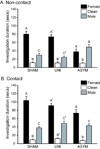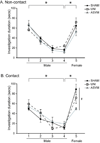Lesions that functionally disconnect the anterior and posterodorsal sub-regions of the medial amygdala eliminate opposite-sex odor preference in male Syrian hamsters (Mesocricetus auratus)
- PMID: 19931356
- PMCID: PMC2814983
- DOI: 10.1016/j.neuroscience.2009.11.024
Lesions that functionally disconnect the anterior and posterodorsal sub-regions of the medial amygdala eliminate opposite-sex odor preference in male Syrian hamsters (Mesocricetus auratus)
Abstract
In many rodent species, such as Syrian hamsters, reproductive behavior requires neural integration of chemosensory information and steroid hormone cues. The medial amygdala (MA) processes both of these signals through anatomically distinct sub-regions; the anterior region (MeA) receives substantial chemosensory input, but contains few steroid receptor-labeled neurons, whereas the posterodorsal region (MePD) receives less chemosensory input, but contains a dense population of steroid receptors. Importantly, these sub-regions have considerable reciprocal connections, and the goal of this experiment was therefore to determine whether interactions between MeA and MePD are required for male hamsters' preference to investigate female over male odors. To functionally disconnect MeA and MePD, males received unilateral lesions of MeA and MePD within opposite brain hemispheres. Control males received either unilateral lesions of MeA and MePD within the same hemisphere or sham surgery. Odor preferences were measured using a 3-choice apparatus, which simultaneously presented female, male and clean odor stimuli; all tests were done under conditions that either prevented or allowed contact with the odor sources. Under non-contact conditions, males with asymmetrical lesions investigated female and male odors equally, whereas males in both control groups preferred to investigate female odors. Under contact conditions, all groups investigated female odors longer than male odors, although males with asymmetrical lesions displayed decreased investigation of female odors compared to sham males. These data suggest that MeA-MePD interactions are critical for processing primarily the volatile components of social odors and highlight the importance of input from the main olfactory system (MOS) to these nuclei in the regulation of reproductive behavior. More broadly, these results support the role of the MA in integrating chemosensory and hormone information, a process that may underlie social odor processing in a variety of behavioral contexts.
Figures



Similar articles
-
Anatomical connections between the anterior and posterodorsal sub-regions of the medial amygdala: integration of odor and hormone signals.Neuroscience. 2010 Oct 13;170(2):610-22. doi: 10.1016/j.neuroscience.2010.06.075. Epub 2010 Jul 8. Neuroscience. 2010. PMID: 20620195 Free PMC article.
-
Chemosensory and steroid-responsive regions of the medial amygdala regulate distinct aspects of opposite-sex odor preference in male Syrian hamsters.Eur J Neurosci. 2006 Dec;24(12):3541-52. doi: 10.1111/j.1460-9568.2006.05216.x. Eur J Neurosci. 2006. PMID: 17229102
-
Neural mechanisms of individual and sexual recognition in Syrian hamsters (Mesocricetus auratus).Behav Brain Res. 2009 Jun 25;200(2):260-7. doi: 10.1016/j.bbr.2008.10.027. Epub 2008 Oct 30. Behav Brain Res. 2009. PMID: 19014975 Free PMC article. Review.
-
The anterior medial amygdala transmits sexual odor information to the posterior medial amygdala and related forebrain nuclei.Eur J Neurosci. 2010 Aug;32(3):469-82. doi: 10.1111/j.1460-9568.2010.07289.x. Eur J Neurosci. 2010. PMID: 20704594
-
Integration of chemosensory and hormonal input in the male Syrian hamster brain.Ann N Y Acad Sci. 1998 Nov 30;855:362-72. doi: 10.1111/j.1749-6632.1998.tb10594.x. Ann N Y Acad Sci. 1998. PMID: 9929628 Review.
Cited by
-
Pubertal testosterone organizes regional volume and neuronal number within the medial amygdala of adult male Syrian hamsters.Brain Res. 2012 Jun 15;1460:33-40. doi: 10.1016/j.brainres.2012.04.035. Epub 2012 Apr 26. Brain Res. 2012. PMID: 22578470 Free PMC article.
-
Loss of TRPC2 function in mice alters sex differences in brain regions regulating social behaviors.J Comp Neurol. 2023 Oct;531(15):1550-1561. doi: 10.1002/cne.25528. Epub 2023 Jul 27. J Comp Neurol. 2023. PMID: 37496437 Free PMC article.
-
Anatomical connections between the anterior and posterodorsal sub-regions of the medial amygdala: integration of odor and hormone signals.Neuroscience. 2010 Oct 13;170(2):610-22. doi: 10.1016/j.neuroscience.2010.06.075. Epub 2010 Jul 8. Neuroscience. 2010. PMID: 20620195 Free PMC article.
-
Differential efferent projections of the anterior, posteroventral, and posterodorsal subdivisions of the medial amygdala in mice.Front Neuroanat. 2012 Aug 21;6:33. doi: 10.3389/fnana.2012.00033. eCollection 2012. Front Neuroanat. 2012. PMID: 22933993 Free PMC article.
-
Functional connectivity of intercalated nucleus with medial amygdala: A circuit relevant for chemosignal processing.IBRO Neurosci Rep. 2022 Feb 2;12:170-181. doi: 10.1016/j.ibneur.2022.01.005. eCollection 2022 Jun. IBRO Neurosci Rep. 2022. PMID: 35199098 Free PMC article.
References
-
- Baum MJ, Keverne EB. Sex difference in attraction thresholds for volatile odors from male and estrous female mouse urine. Horm Behav. 2002;41:213–219. - PubMed
-
- Bean NJ, Nyby J, Kerchner M, Dahinden Z. Hormonal regulation of chemosignal-stimulated precopulatory behaviors in male housemice (Mus musculus) Horm Behav. 1986;20:390–404. - PubMed
-
- Beauchamp GK, Yamazaki K. Chemical signalling in mice. Biochem Soc Trans. 2003;31:147–151. - PubMed
-
- Beyer C, Morali G, Larsson K, Soderstein P. Steroid regulation of sexual behavior. J Steroid Biochem. 1976;7:1171–1176. - PubMed
-
- Bialy M, Sachs BD. Androgen implants in medial amygdala briefly maintain noncontact erection in castrated male rats. Horm Behav. 2002;42:345–355. - PubMed
MeSH terms
Grants and funding
LinkOut - more resources
Full Text Sources

